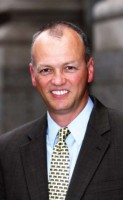Bank On It
Capital One’s Steve Hemperley believes New Orleans is impervious to recent fluctuations in the economy
With all the recent news of banks struggling around the country, Steve Hemperley, theNew Orleans city president for Capital One Bank, isn’t worried about his territory.
“New Orleans is a good market to begin with, and when you frame us in context of the national economy right now, we’re very stable and solid,” he says, adding that BusinessWeek recently named New Orleans one of the country’s most recession-resistant cities.
According to Hemperley, the New Orleans economy never overheated from the exaggerated levels of capital that poured into other cities around the country, so it never suffered the downside. In other words, we never soared high enough to crash hard. Since autumn, when several stalwart Wall Street institutions failed, the stock market tanked and the gravity of the economic crisis broke into public consciousness, Capital One hasn’t changed its strategies.
“We’ve stuck to good-old fashioned banking and stayed away from higher-risk activities, so we haven’t had to change the way we do business very much at all, ” Hemperley says. “We’re still lending money. The credit crunch doesn’t affect every bank that’s out there.”
Capital One, which is based in McLean, Virginia, will still receive some of the federal bailout money, however. Hemperley didn’t provide details on how the parent organization will use its government funds, but many stronger banks around the country are using the influx of capital to make acquisitions of weaker institutions, which economists say will shore up the industry. Banking analysts believe an acquisition is what Capital One As longtime New Orleanians know, Capital One first came to the Crescent City through an acquisition—its purchase of Hibernia Bank in 2005. (Capital One, which originally grew as a credit card company, has also shouldered its way into the New York and New Jersey banking market through an acquisition of North Fork Bank.) Since Hibernia “ain’t dere no more,” in locals’ minds, Hibernia green has taken its place next to K&B purple.
“We’re proud of the Hibernia legacy, and people in New Orleans do have loyalty to the Hibernia name,” admits Hemperley. “But the main thing is our customers are more satisfied now. We’re a better capitalized, more technology-oriented and more creative company than before.” Hemperley himself has been with the bank 20 years. “There were not a lot of personnel changes during the transition. Many of us are still with the company.”
And Capital One keeps investing in the metropolitan area, with around 60 branches total. It has opened up a drive-up branch on St. Charles Avenue and another bank on Highway 59 in Mandeville. Meanwhile, a new facility is under construction in Gentilly on Elysian Fields Avenue. Capital One was the first bank to restore full-service banking in East New Orleans after Hurricane Katrina, according to the company, and the majority of damaged branches have been rebuilt. “Obviously, Katrina had a huge impact on us, but in the end we came through it in good shape, and most of our current issues are related to post-Katrina events like shifts in
population,” he says. “It doesn’t mean we’re not affected by the larger economic issues, but the banks in New Orleans have been stress-tested already.”
As part of its corporate citizenship, Capital One sponsors a variety of community activities, including a key sponsorship of the Hornets basketball team. One recent program sponsored by the bank is called Finance Park, which is a mobile, miniature city of semi-trucks set up to teach financial literacy to high school students. The students start the day by receiving a life scenario, including their job, salary, family
situation and existing financial commitments. They visit different stations like grocery stores and auto shops to learn to make the most of their budgets.
While Hemperley has been involved in banking his entire career, he jokes, “I wasn’t born with wingtips on my feet.” He grew up in Vivian, Louisiana, a small town in the far northwest corner of the state and trained to
be an oil-and-gas geologist at Louisiana Tech. When he graduated in the mid-1980s and put himself on the New Orleans job market, the precipitous end of the local oil boom derailed his plans. He stuck around and decided to go to UNO to earn an MBA. Immediately after graduation, Hemperley found his job in the commercial banking wing of Hibernia and rose through the ranks. He was promoted to the New Orleans president position in January.
Along the way, he met his wife, Andrea, a New Orleans native who currently works for a hotel group, and together they have three children. “Andrea loves her job because she gets to sell the city every day,” says Hemperley.
And clearly Hemperley loves his job, too. “People think of banking as a slow-changing business, but that’s not true. We’re fast adapters of technology, and there’s so much going on in the industry right now. It’s an exciting place to be.”

